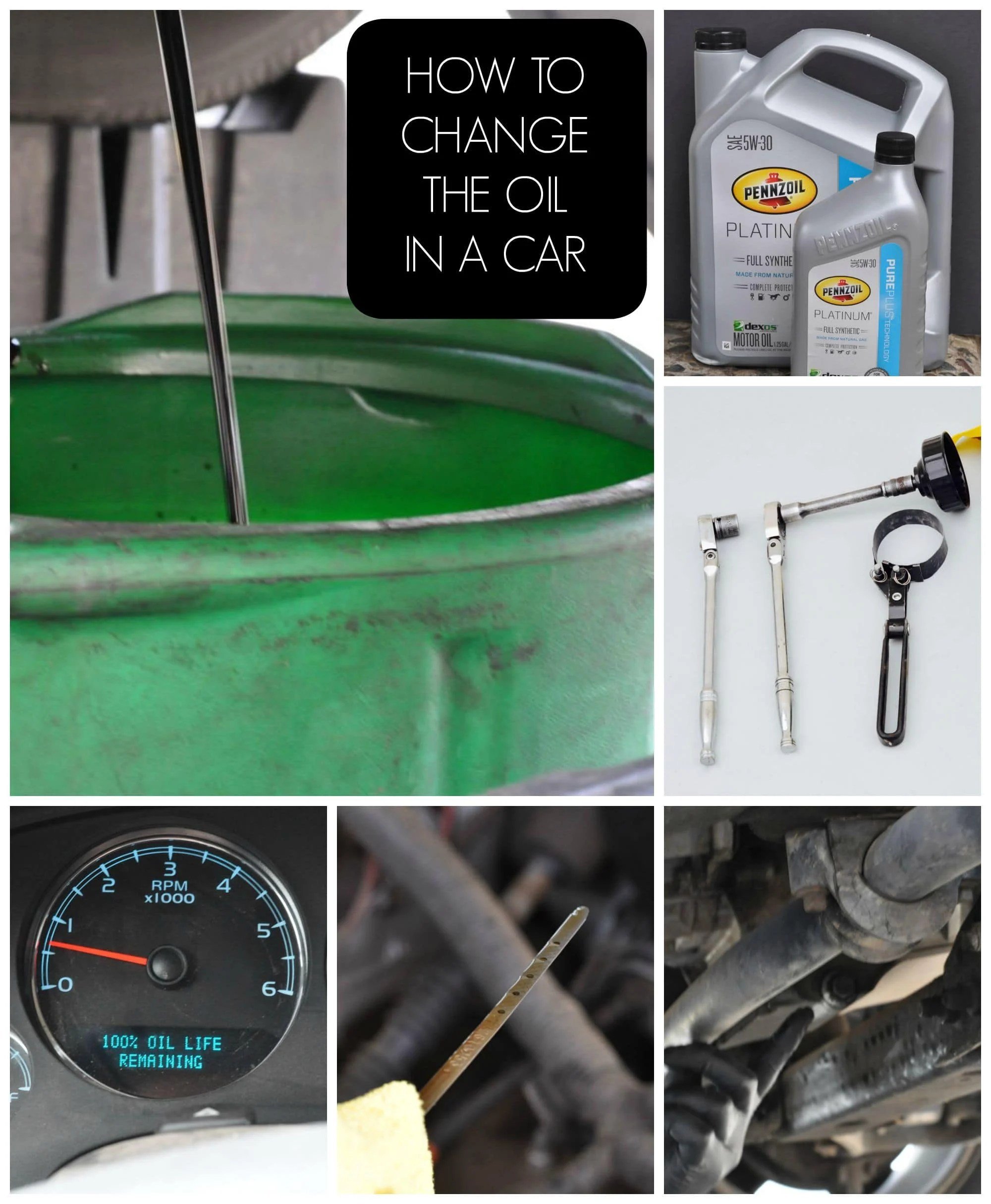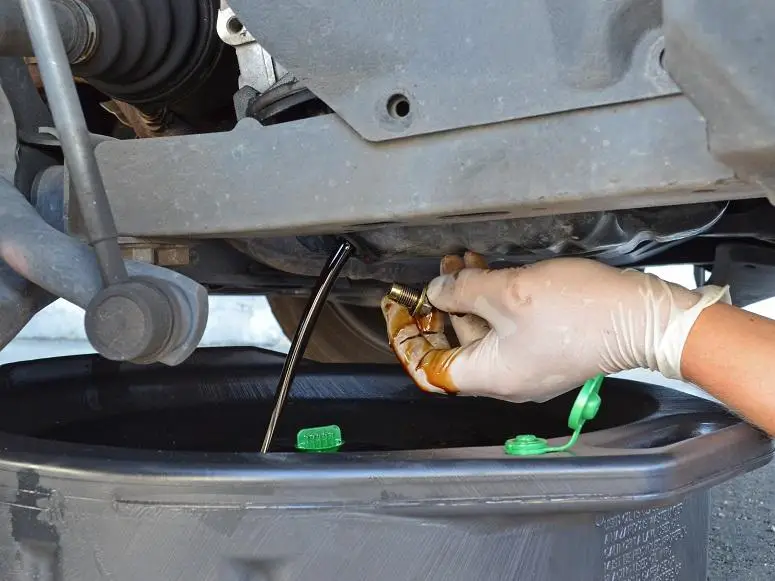Tip #: Ensure The Correct Weight
All engines have specific oil weights that should be used in each particular engine. This varies by make and model, but most modern cars have the weight printed on the oil fill cap under the hood. If not, there may be a small sticker that identifies what your engine requires. The weight of your oil should always be matched with the one recommended by the manufacture. No exceptions. You can read more about the different types of motor oils on our blog here.
Replacing The Oil Filter
Introduction: How To Do An Oil Change
Tools Required
- A ratchet and a socket set
- Oil filter wrench
Safety tips:
- Dont work under a car supported by a jack alone use jack stands.
- Oil should be warm before changing. If your car is hot or has been running, let it cool. If it was sitting cold – run it for a few minutes.
- When its time to install the new oil filter, only hand-tighten the filter – never use a wrench to tighten it.
You May Like: How Much Commission Does A Used Car Salesman Make
Drop In Fuel Efficiency
If theres not enough clean oil inside your engine, it wont perform efficiently. You will notice that your visits to the gasoline station are more frequent.
Why is that? The culprit could be the exhaust system or your cars fuel system.
But then again, dont discount the possibility that the lack of oil or old engine oil is causing the problem because this is also one of the signs you need an oil change. If youve been on a long trip or are making long trips frequently, you should change your engine oil more often.
How Much Does An Oil Change Cost

The largest cost in a typical oil change is the oil itself. Oil prices range widely, but a car or truck usually needs 4 to 6 quarts of motor oil. Oil prices vary, but generally, a quart starts at $4.00 and goes from there. Special viscosity synthetic oils for some modern cars can be considerably more expensive. Oil filters and drain plug gaskets are generally inexpensive, in the range of a few dollars for a common brand and type. For most cars, you should be able to do an oil change for under $50sometimes a lot less.
Also Check: Repairing Burn Holes In Car Seats
How Often Does Maserati Recommend An Oil Change
Mesaratis require an oil change every 10,000 to 15000 miles. Considering that the average driver clocks an average of 13000 miles per year, its safe to say you should change your Maserati Oil once every year.
However, Some owners change their Maserati oil more than once a year. While it doesnt necessarily harm your vehicle, changing your car oil too soon will only cost you more money.
How Often Should I Change My Cars Oil
Grandpa always told you to change your oil on a regular basis. But what does regular mean? How often you should perform this service depends on the vehicle type, oil type and driving conditions.
Oil change intervals for older vehicles
Cars built more than a decade ago typically use conventional engine oil instead of synthetic. The guideline has always been to change oil in these vehicles every 3 months or 3,000 miles. Some manufacturers might push things a little further, recommending a 5 month or 5,000-mile interval.
A more frequent interval should be followed for vehicles driven under one or more of the following:
-
Consistent short trips under 5 miles
-
Extreme temperatures or dusty climates
-
Excessive stop-and-go driving
-
Towing or hauling heavy loads
Oil change intervals for newer vehicles
Many modern vehicles including Lincolns recommend using synthetic engine oil. Typically, these vehicles are also equipped with an oil life monitoring system to tell you when an oil change is required. These systems used to be somewhat inaccurate, as they calculated oil life based on times and miles. Newer versions analyze engine operating conditions to determine when the oil begins to degrade. This makes them much more reliable and eliminates the severe service schedule. Now, the vehicle can detect driving conditions that may affect oil life.
South Bay Lincoln service can also provide guidance and answer any oil change questions you may have.
Oil change services
-
Lubrication
You May Like: Removing Hail Dents From Cars
Change The Oil Filter
Remove the oil filter. New filters that are properly installed don’t go on terribly tight. But they can be hard to get off later because their sealing gaskets swell over time.
Here I’ve added an extension to my ratchet to get a little extra knuckle room. But I’m not going to use the wrench much beyond the point of breaking the filter free. Filters loosen in a hurry, at which point oil starts to gush out all around the perimeter. Go slowly and switch to unscrewing the filter by hand as soon as you can.
Unlike drain plug removal, there is no way to avoid making a mess at this stage. Make sure you reposition the drain pan before you start. Have rags handy and prepare to get some oil down your arm. Don’t let go of the filter once it starts to come off.
Hold the filter over the pan to drain it, but try not to drop it in. It makes a very messy splash.
Use rags to clean as much oil away as you can, paying special attention to the filter sealing surface. Make sure to remove the old filter’s O-ring if it stuck itself to the surface. This rarely happens nowadays, but it’s one of those things you check anyway because a double stack of O-rings won’t seal, allowing your new oil to pump out and ruin your engine.
The last messy step involves smearing a dab of new oil on the new filter’s O-ring.
Install the new filter. At this point I like to take the gloves off so I get a good grip. I’m spinning the filter on gently until the O-ring makes first contact with the sealing surface.
Jack It Up Open It Up
First, you’ll want to lift the car high enough to give yourself room to work under it. Whether you use a hoist, ramps, or jack stands, make sure you are being absolutely safe. Never work under a car that is held up only by a floor jack. We raised our subject vehicle on the lift in the Car and Driver test garage, so you could see what we were doing. Most modern cars are fitted with a plastic undertray to both improve aerodynamics and protect vital components on the underside of the engine. In order to access the oil pan and oil filter on the TSX, the cover needs to be removed most undertrays are held on with a mixture of bolts, screws, or plastic clips that can be unfastened with basic hand tools. Before step two, be sure to examine the area for oil leaks. If any are found, consider having your vehicle inspected by a mechanic.
Recommended Reading: Average Commission For Car Salesman
How To Change Oil In A Car Step By Step
If you know how to change your car oil yourself, it becomes very convenient and economical to carry out the recommended motor oil checks. A well-lubricated engine not only runs smoothly but it also extends your vehicles value.
Unlike what most lube shops make you believe, changing your own oil is a relatively easy task. The process starts by getting the correct type of oil for your vehicle. This should be indicated somewhere in your cars manual, although you can also enquire online. Collecting the necessary tools for changing engine oil beforehand will also make the entire process a breeze.
What Those Dashboard Lights Mean
It’s best to keep track of the miles you drive between oil changes, though newer model cars make this easier with a dash indicator that tells you it’s time to head to the shop, as part of what is called an oil life monitoring system. These systems track your mileage and also use data from your driving that’s analyzed by your car’s computer to determine when your car needs an oil change. When the light illuminates, it’s best to get the oil changed as soon as possible, but it’s not necessarily urgent.
If your car has an oil life monitoring system, note that this light is different than your oil pressure light, which illuminates on your dash if your car’s oil isn’t flowing properly due to low level, a failing oil pump, a leak in the system or some other issue. Learn the difference between the two dash lights, because if the oil pressure light comes on, you need to stop driving as soon as possible to avoid engine damage.
Get in the habit of checking your oil at least once a month to ensure your car’s not leaking or burning oil. If the level is low, add oil. Good oil should be a clear brown-black color, though the Automobile Association of America cautions that color is not the only indicator of oil life. If the oil is murky or opaque, it might be time for a change, and if it’s milky, your engine may be leaking coolant. If your car has one of the aforementioned oil monitoring systems, though, you might not have a dipstick to check the oil.
Don’t Miss: Repairing Clear Coat On A Car
Pros And Cons Of Changing Your Own Oil
Changing your oil the first time can take a while depending on your knowledge of cars and your skill level. You also need to spend time and money gathering all the necessary tools and supplies. After the oil change, you must take the old oil somewhere to dispose of it properly. Changing your oil can also be a messy and dirty job.
The good news is that changing your own oil goes faster once you know how to do it. Sometimes it can take as little as 15 minutes. You may even enjoy the satisfaction of taking care of your own vehicle, and after the initial tool investment, youll save money by doing it yourself.
If you dont have the time or skills needed to change your own oil, its easier for you to schedule an oil change at your local dealership. Simply show up and wait in a comfortable room while a technician with professional tools performs the task quickly. For greater peace of mind, leave your oil changes up to our quality service technicians, who know whats best for your vehicle.
If you decide to change your oil, its a good idea to keep a maintenance record. Recording your vehicles mileage will help you know when its time to change your oil again. The general rule is every 3,000 to 5,000 miles, but it depends on the type of vehicle you drive. For some vehicles, youll need to reset the maintenance required light so it can alert you when its time to change your oil.
Tips For A Successful Oil Change

One of the most common do-it-yourself car maintenance jobs is the classic oil change. A simple process, yes, but it is always important to refresh your memory, so you fully understand what it takes to have a completely successful oil change. And if you have never changed your own oil before, welcome! We hope this guide can become handy in your learning and understanding on how to change your cars oil.
Don’t Miss: How To Get Rid Of Carpet Beetles In My Car
Color Change From Amber To Black
In the course of collecting heat, soot, and metal chirpings, the oil will change from its usual amber color to black soot. Additionally, the accumulation of carbon changes the oil into a thick sludge. To check the oils quality and color, remove the dipstick and wipe off the residual oil. Next, insert the dipstick in and remove it again. If the oil residual is amber to dark color, its probably fine. However, if its black and thin, its time for an oil change.
Place The New Oil Filter
Every time you change your engine oil, it is already expected that youre going to replace the oil filter as well. Also change the O-rings while youre at it to help ensure a leak-free system. Lubricate the O-ring with the new engine oil you are going to fill your engine with. This helps ensure a perfect seal. Now, put the oil filter and tighten the filter cap. Make sure to apply the recommended torque force when tightening the cap.
Read Also: How To Make Aroma Beads Dry Faster
Secure Your Car In A Flat Stable And Even Terrain And Raise It
Park your car in a flat, even, and stable terrain. Make sure to put your car in the Park position if its an automatic, or Neutral if manual. Engage the parking brake or handbrake, too. Now use an alligator-type hydraulic jack to raise your vehicle. If you have a vehicle trestle, now is the perfect time to use it to support one or two of the lift beams on the underside of your car. You should never use a single jack only as this is quite risky.
Check The Oil Level Check For Leaks
Finally, after waiting a few minutes for the oil to settle into the pan, use the dipstick to verify that your oil is at the proper level. Checking your oil is simple: Pull the dipstick from its tube, wipe away all oil with a paper towel, reinsert the dipstick, remove the dipstick, and confirm that the oil is lined up with the full marking on the tip of the dipstick. Finally, start the vehicle and let it idle and warm up check for leaks under the vehicle and around the oil filter.
Congratulations! You’ve changed your oil and saved a bunch of money. Now, doesn’t that feel great?
Don’t Miss: Forza Horizon 3 300 Mph
How To Change Your Own Oil
Prevent engine trouble and save yourself some money by having your vehicles oil changed regularly. Some people prefer to take care of this task themselves rather than taking their vehicle in for maintenance. Heres everything you need to know about how to change your own oil and why its important to do so in a timely way.
Changing Your Oil Protects Other Engine Parts
What does oil actually do in my car? Inside your engine there are a many key parts which make your engine run such as the crank shaft and the connecting rods. These rods control the pistons insde of your engines cylinders. There is also another piece called the camshaft which assists in opening and closing the vehicles exhaust valves. Making sure that you have clean oil in your vehicles engine is crucial in keeping of of these components well moving and running properly.
Read Also: Altindal Hail Protector Car Cover
What About Synthetic Oil Changes
Synthetic oil is comprised of the same chemical compounds found in petroleum molecules in the refined crude oil that comprises conventional oil. However, synthetic oils compounds are artificially synthesized. Synthetic oil has a few advantages over conventional oil, the most notable being lower oil change intervals. Talk with us to discover if synthetic oil is suitable for your vehicle.
When Is The Safest Time To Change My Oil

It depends on what the manufacturer has recommended for your car. To be safe, you should consult your cars operators manual.
In the past, most car mechanics recommended changing the oil every 3,000 miles or three months, whichever comes first. But today, with the advances in oil technology, they are now recommending oil changes every 5,000 miles and even every 10,000 miles.
Don’t Miss: How To Keep Car Doors From Freezing Shut
Where Can I Get My Oil Changed
If you live in Vancouver, Edmonton, Red Deer, London, or Toronto, there are plenty of local Go Auto dealerships for you. But if you live somewhere else, theres always JiffyLube, Mr. Lube, car dealerships, tire shops, and local mechanics. If youre capable, you can even do it in your driveway!
Heres how you can go about finding the best place for you.
